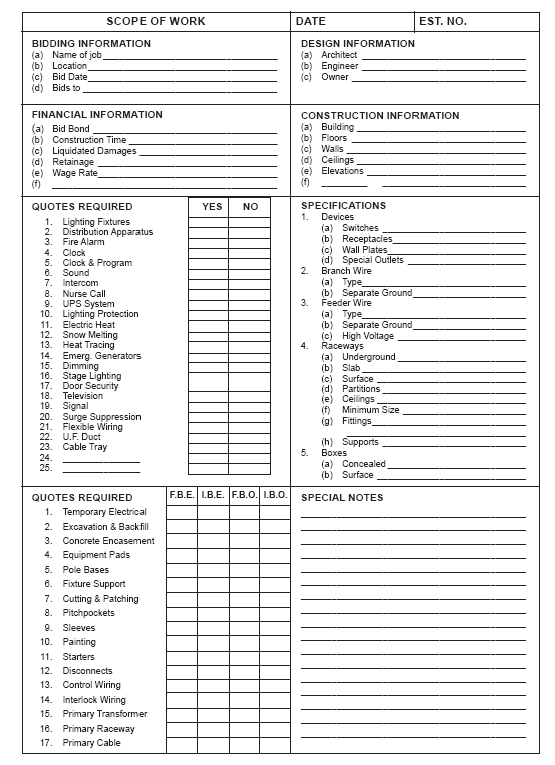Scope of Work
Specified Materials
The type and grade of materials to be used for the job will be defined in the electrical specifications, and is to be noted on the Scope of Work sheet. For example:
1. Devices:
(a) Switches 20A Spec Grade Gray
(b) Receptacles 20A Spec Grade Gray
(c) Wall Plates .302 Stainless Steel
(d) Special Outlets 20A Isolated Ground
2. Branch Wire:
(a) Type THHN Copper
(b) Separate Ground With PVC
3. Feeder Wire:
(a) Type THHN Copper
(b) Separate Ground Yes
(c) High Voltage No
4. Raceways:
(a) Underground PVC
(b) Slab GRC
(c) Surface EMT
(d) Partitions EMT
(e) Ceilings EMT
(f) Minimum Size 1/2”
(g) Fittings Die Cast Set Screw
This section of the specifications must be read thoroughly and carefully, as it will define the cost responsibilities of the electrical contract, and also determine the scope of electrical work. As each page of the specifications is read, you should make notes pertaining to the scope of the electrical work. For example:
Quotes that will be required
• Light fixtures.
• Distribution equipment.
• Floor duct.
• Bus duct.
• Cable tray.
• Fire alarm.
• Sound and paging systems.
• UPS systems.
• Special wiring systems.
• Dimming systems.
• Any other special systems.
Responsibility of costs
Determining responsibility of costs (who pays for what) is extremely important. If the specifications do not clarify these areas of costs, submit a list defining what costs your price is based upon along with your bid price.
• Excavation and backfill.
• Pole bases, equipment pads, miscellaneous concrete work.
• Safety switches.
• Motor starters.
• Light fixture support.
• Temperature control wiring.
• Interlock wiring.
• Special system wiring.
• Primary raceway and cable.
• Primary transformer.
• Painting.
• Pitch pockets.
• Cutting and patching.
